![]()
![]()
![]()
Use LEFT and RIGHT arrow keys to navigate between flashcards;
Use UP and DOWN arrow keys to flip the card;
H to show hint;
A reads text to speech;
109 Cards in this Set
- Front
- Back
|
Q1A transdermal fentanyl patch is often used for management of cancer pain. After application, the time to reach peak plasma levels is: A. 1hr B. 2hrs C. 4hrs D. 12hrs E: 24hrs |
E. 24 Hours CEACCP Transdermal opiates: Fentanyl: Afterinitial application, a depot of fentanyl forms in the upper skinlayers and serum fentanyl concentrations increase gradually, generallylevelling off between 12 and 24 h. The steady-state serumconcentration is reached after 24 h and maintained as long as thepatch is renewed. |
|
|
Q2: Pharmacological studies are undertaken in several phases. A phase 3 study involves: A Animal studies B Testing of drug on healthy volunteers C Observational studies on patients with disease D Post marketing surveillance E Randomised controlled trials on target population |
E RCT on target popuations Phase 1: small study for PK/dose on healthy Phase 2: Target populationPhase 3: Large RCT Phase 4: Post marketing surveillance (thousands of patients) |
|
|
Q3: A pregnant patient 28/40 gestation is involved in a high-speed MVA. On admission to the DEM she complains of sudden onset severe chest pain. Her vital signs show HR 120, BP 160/100, SpO2 95% RA and her ECG shows ST depression. Most likely diagnosis is: A. Cardiac contusion B. Tension pneumothorax C. Aortic dissection D. Sternal fracture E. Myocardial infarction |
C. Aortic Dissection Pregnancy is risk factor for Aortic Dissection as is deceleration injury. |
|
|
Q4: A 5 year-old child with recently diagnosed Duchenne muscular dystrophy has an inhalation induction with sevoflurane for closed reduction of a distal forearm fracture. No other drugs have been given. 10 minutes later the child suffers a cardiac arrest. After a further 5 minutes a venous blood sample shows a potassium level of 8.5mmol/L. The most likely mechanism for the hyperkalaemia is: A MH B ARF C Cardiomyopathy D Rhambdomyolysis E Crush injury |
D CEACCP 11 No 4 Depolarizing neuromuscular blocking agents must be avoideddue to the extra-junctional synapse development that occurs inDuchenne muscular dystrophy and Becker’s muscular dystrophy.Catastrophic hyperkalaemia can result from depolarization of thesynapses, as well as from rhabdomyolysis that occurs due todamage caused to the muscle cell membrane. |
|
|
Q52: A 30yr old pregnant patient develops contractions at 30/40 gestation. Which of the following can not be used for tocolysis? (Question does NOT ask about 34/40) A. Clonidine B. Indomethacin C: Magnesium D. Salbutamol E. Nifedipine |
A NSWpolicy PD2011_025 |
|
|
Q53: In a patient with intraorbital haemorrhage, following local anaesthetic injection, the adequacy of occular perfusion is best assessed by: A. Angiography B. Indirect opthalmoscopy C. Direct opthalmoscopy D. Intra-occular pressure tonometry E. Palpation of the globe by an experienced physician |
C - direct opthalmoscopy |
|
|
Q54:What is the appropriate post-operative ibuprofen dosage for a one year old child tds? A. 5mg/kg B. 7.5mg/kg C. 10mg/kg D. 15mg/kg E. 20mg/kg |
C |
|
|
Q55:You are inducing a 4yr old child with Arthrogrophysis multiplex congenita. After you administer the induction agents, you find it difficult to place the laryngoscope. What is the likely complication? A. Malignant hyperthermia B. Neuroleptic malignant syndrome C. TMJ rigidity D. Opioid-induced rigidity E. Inadequate depth of anaesthesia |
C. Congenital disorder with contracture of multiple joints. 25% have TMJ involvement |
|
|
Q56: What is the best measure of the anticoagulant effect of Dabigatran? A. APTT B. Dilute thrombin time C. Prothrombin time D. Bleeding time E. TEG |
B dilute thrombin time |
|
|
Q57: What is the ratio of compression to breaths for neonatal resuscitation? A. 3:1 B. 15:1 C. 30:1 D. 15:2 E. 30:2 |
A 3:1 |
|
|
Q60: In patients with refractory elevated ICP, bilateral decompressive craniectomy is associated with reduction in ICP and also results in: A. Reduced duration of ventilation B. Reduced duration of hospitalisation C. Improved overall mortality D. Worse long-term neurological outcome E. Unchanged long-term neurological outcome |
DECRA trial - decreased ICP, decreased mechanical ventilation, worse scores on extended glascow coma scale (?worse neurological outcome) A > D |
|
|
Q61:Tumour lysis syndrome causes all of the following biochemical abnormalities EXCEPT: A. Hyperkalaemia B. Hypernatraemia C. Hyperphosphataemia D. Hyperuricaemia E. Hypocalcaemia |
B Hypernatraemia |
|
|
Q66 You are performing an interscalene nerve block using a nerve stimulator when your patient begins to hiccough. You should aim to position the tip of your needle more A) Anterior B) Posterior C) Cephalad D) Caudal E) Superficial |
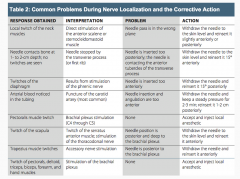
B. Stimulation of phrenic nerve |
|
|
Q67 The characteristic respiratory pattern in a patient with an acute C5 spinal cord injury is A. Rapid respiratory rate B. Arterial hypoxaemia C. Chest wall immobility D. Preserved cough E. Preserved inspiratory force |
A |
|
|
Q68 Tavi vs Max medical therapy nonoperable aortic stenosis reduction in risk at 30 days of A. AMI B. AKI C. Death D. Atrial fibrillation E. Stroke |
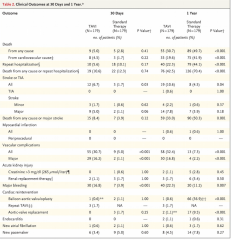
A seems most sensible of all wrong answers. PARTNER trial showed increased death, increased stroke at 30 days. Less AF and AKI (though not stat significant) - and TAVI has been associated with both of these in other studies. |
|
|
Q69 Medial peribulbar block tip max distance past equator for minimal vein injury A. 5mm B. 10mm C. 15mm D. 20mm E. 25mm |
B. 10 mm ANZCA podcast apparently says it. multiple sources say 25mm total depth, Globe is 25mm in all directions i.e. 10-12.5mm seems appropriate |
|
|
Q76: A patient has suffered flash burns to half of the left upper limb, all of the left lower limb and the anterior surface of the abdomen. The approximate percentage of the body surface which has been burnt is: A. 18% B. 23% C. 32% D. 41% E. 48% |
C 32% Half upper limb 4.5, left lower limb = 18, anterior abdomen = 9, total is 31.5% |
|
|
Q77: You are anaesthetising an ASA 1 woman for a laparoscopic gynaecological procedure. How long does it take for the PaCO2 to peak? A. <15min B. 15-30min C. 30-60min D. 60-90min E. >90min |
B. 15-30min See:http://web.squ.edu.om/med-Lib/MED_CD/E_CDs/anesthesia/site/content/v04/040260r00.HTM During uneventful CO2 -pneumoperitoneum, PaCO2progressively increases to reach a plateau 15 to 30 minutes after the beginningof CO2 insufflation in patients under controlled mechanical ventilation duringgynecologic laparoscopy in the Trendelenburg position |
|
|
Q82: Anaemia post partial gastrectomy is most likely due to: A folate deficiency secondary to steatorrhea B ongoing haemorrhage from stomal ulcer '(yes Stomal not stomach)' C malabsorption of iron D Vit B12 deficiency due to loss of intrinsic factor E folate deficiency due to lack of appetite |
C - "Anemia was frequent after gastrectomy for early gastric cancer, with iron deficiency being the major cause" -World J Gastroenterol. 2012 Nov 14; 18(42): 6114–6119 |
|
|
Q83: 65year old for video assisted thoracoscopic lower lobe wedge resection. Surgeon requests lung isolation and one lung ventilation.Predictors of intraoperative hypoxia are: A central rather than peripheral lesion B left sided lesion C low Aa Oxygen gradient when ventilating both lungs D right sided lesion E supine rather than lateral position |
D & E predictive of hypoxia A & B negative predictor of hypoxia C if this means loe paO2 then this is also predictor of hypoxia CEACCP.Hypoxaemia during one-lung anaesthesia Factorspredictive of hypoxaemia during OLV include: * ventilation of the left ratherthan the right lung, * low oxygen partial pressure on two lungs, * absence ofreduction of perfusion to areas of lung pathology * and supine position ratherthan the lateral decubitus position |
|
|
Q94: Small air bubbles in the arterial line system will reduce A. Dampening coefficient B. ?Extrinsic Coefficient C. Measured systolic pressure D. Measured MAP E. Resonant frequency |
E >C Bubble increases damping which reduces resonant frequency of transducer system. This may cause overdamping which will decrease measured systolic pressure |
|

Q95: Capnograph trace form a patient that is intubated and ventilated. What does it indicate? A. Endotracheal intubation B. Gas sample line leak C. ETT cuff leak D. Obstructive disease E. Spontaneous breaths |
B. Gas sample line leak |
|
|
Q98' You extubate a young woman after a dental procedure under GA. She has a history of hereditary angioedema and in recovery she develops airway oedema. Best treatment A. FFP B. IV Adrenaline C. IV corticosteroids D. IV promethazine E. Nebulized adrenaline |
A replace C1 esterase inhibitor |
|
|
Q99 A previously well 65 year old female develops acute shortness of breath 3 days post hip replacement. The most appropriate investigations to confirm PE is A. CTPA B. D-dimer C. Echo D. Ecg E. V/Q scan |
A |
|
|
Q100 20 year old female with 25% burns to her body. She weighs 80 kg. How much replacement fluid should she be given over the next 8 hours? A. 4L B. 4.8L C. 5L D. 6L E. 8L |
Answer A 4 x 25 x 80 = 8L so give 4L in first 8h |
|
|
Q101 50 y.o female with a history of mennohhragia is having a hysterectomy. Her pre-operative Hb is 95. What serum ferritin would confirm iron deficiency anaemia? A. 30 mcg/L B. 3 mg/L C. 3 mcg/L D. 0.3 mg/L E. 3000 mcg/L |
C |
|
|
Q102 An Adult Jehovah's Witness requires a redo hip replacement for a peritrochanteric fracture. They request that no blood products are given. The anaesthetists decision to PROCEED is best given by: A. Autonomy B. Beneficence C. Justice D. Nonmaleficence E. Paternalism |
A |
|
|
Q103 100% Saturated air @ 20 degrees is what relative humidity @ 37 degrees A. 20% B. 30% C. 40% D. 50% E. 60% |
C at 20 degrees fully saturated content is 17, at 37 degrees 44 ~ 18/44 = 40% |
|
|
Q104 Maximum cumulative dose of intralipid (ml/kg) A. 10 B. 12 C. 15 D. 20 |
B 1.5ml/kg bolus, 15ml/kg/hr for 30mins, repeat bolus at 5 mins and double rate, max 12ml/kg |
|
|
Q105 60yo alcoholic with HTN, has abdominal pain. No findings at laparotomy. 12 hrs later: Na140 k5 cl115 HCO3 18. What is the most likely diagnosis? A. ARF B. Diabetic ketosis C. Lactic acidosis D. Methanol E. NaCl infusion |
E. NaCl infusion causing hyperchloremic acidosis
Normal AG acidosis A = Addison's B = Bicarb loss (diarrhea, vomiting, fistulas) C = Chloride D = Drugs (Acetazolamide, acids) Raised AG acidosis C = CO, CN A = Alcoholic ketoacidosis and starvation ketoacidosis T = Toluene M = Metformin, Methanol U = Uremia D = DKA P = Propylene glycol, paracetamol, paraladehyde I = Iron, Isoniazid L = Lactic acidosis E = Ethylene glycol S = Salicylates |
|
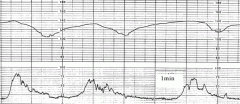
Q106 . Causes: A. Uteroplacental insufficiency B. Foetal head compression C. Foetal asphyxia D. Umbilical cord compression E. General anaesthesia |
A Late decelerations (start at peak of contraction and persist after contraction finished) -> uteroplacental insufficiency (maternal hypotension, uterine hyperstimulations, pre-eclampsia) Early decelerations due to head compression - normal Cord compression - variable decelerations - resolve with change in position Late decelerations - utero-placental insufficiency GA - no decelerations, reduction in HR and variability |
|
|
Q107 In a clinical trial, researchers looked at 2 groups - smokers vs. non-smokers and followed then up for a period of time. This type of study is a A. Cohort B. Case study C. Observational D. RCT E. ? |
A Cohort study Although cohort is a type of observational study |
|
|
Q110 Prothrombinex VF is useful in the perioperative period to correct the coagulopathic defect of all of the following except A. Isolated factor II deficiency B. Isolated factor VII deficiency C. Isolated factor IX deficiency D. Isolated factor X deficiency E. Warfarin |
B Not used in factor V or Factor VII contains 9,2,10 and small levels of VII |
|
|
Q111 A 65 year old man otherwise fit and healthy is having a TKR under GA (O2, N2O, sevoflurane and fentanyl). His blood pressure has been stable through-out the case at 130/80. Before the orthopaedic surgeons start reaming and bone cemetation you should A. Give heparin 5000 iu B. Give a corticosteroid C. Cease N2O D. Induce hypotension E. Give a vasopressor to increase blood pressure |
Answer C Oxford handbook 469 - though seems pretty stupid |
|
|
12 year-old with idiopathic scoliosis, most likely have associated A. Phaemochromocytoma B. Renal artery stenosis C. Mitral valve prolapse D. Diabetes insipidus E. ? abnormality with the larynx |
C Thoracic scoliosis is associated with mitral valve prolapse |
|
|
Term neonate, noted to have intermittent stridor few days after birth, then parents also notice stridor during feeding and sleep. Otherwise normal and healthy. Most likely condition is A Cri-du-chat syndrome B Laryngomalacia C Tracheomalacia D Laryngocoele E ? something to do with cord paralysis |
B Laryngomalacia is the commonest cause of neonatal stridor. It is typified by inspiratory stridor, which worsens with feeding, agitation, and supine positioning |
|
|
A picture of an echo 4 chambers view: A Anterior mitral valve leaflet B Posterior mitral valve leaflet C ? Aortic non-coronary D ? Tricuspid E |
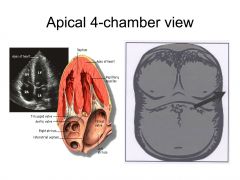
Answer A or B The anterior leaflet is close to the inter-atrial septum, the posterior leaflet is lateral |
|
|
Cryoprecipate, once thawed must use within: A 30 minutes B 2 hours C 4 hours D 6 hours E 12 hours |
D - 6 Hours |
|
|
Glycine 1.5% used for TURP, osmolality is: A 200 B C D 300 E 320 |
A 200mMol |
|
|
Sick ICU patients seem to have moderate - severe ARDS PaO2/FIO2 ratio of 200, C.I. 1.7 (cardiac function seems okay). Decided to have ECMO, best mode is A AV B VA C VV D ? arterior-arterial E ? atrio-aortic (yes that's how they spelt it) |
C - VV ECMO -used for ARDS when cardiac support not required , less complications than VA ECMO CEACCP - ECMO |
|
|
Middle age women c/o pain in hands when hanging out washing. Also found to have muscle wasting on one of the hand associated with weaker radial pulse. A CRPS B Lateral medullary syndrome C Thoracic outlet syndrome D Paraneoplastic syndrome E |
C. Thoracic Outlet syndrome CEACCP anaesthesia for vascular surgery of upper limb |
|
|
Same radial nerve question with photos of a probe over postero-lateral upper arm and ultrasound image that show a triangular shape nerve, most likely the radial nerve. Injecting 5 ml of 0.75% [[ropivacaine] will produce sensory block over A Medial forearm B Lateral forearm C Dorsum part of hand D Plantar surface of ring and little finger E Plantar surface of middle and ring finger |

C. Dorsum part of the hand |
|
|
Blue urticaria is a complication of A B Methylene blue C Patent blue V D E |
C Patent blue V |
|
|
Intraosseous sampling - least accurate on: A Albumin B Urea C ? Na or K D Chloride E |
C There was a significant correlation between intravenous and IO samplesfor red blood cell counts and hemoglobin and hematocrit levels but not forwhite blood cell counts and platelet counts. There was a significantcorrelation between intravenous and IO samples for glucose, blood ureanitrogen, creatinine, chloride, total protein, and albumin concentrations butNOT for sodium, potassium, CO(2), and calcium levels |
|
|
Subtenon's block - muscle most likely to have inadequate block A Medial rectus B Lateral C Superior D Superior oblique E Inferior |
D Superior Oblique |
|
|
EVAR, best method to reduce risk of renal impairment A Sodium bicarbonate B N-acetylcysteine C Normal saline D E |
C. Normal Saline CEACCP EVAR |
|
|
EVAR is preferred over open AAA repair because A Lower cost B Lower mortality C Less follow up D Less re-intervention E Less need for critical care |
E. Less critical care less operative mortality but not less total mortality |
|
|
Laser flex tube with double cuffs - how to inflate cuff(s)? A Inflate proximal then distal B Inflate distal then proximal C Both cuffs filled with saline D Inflate distal only E Inflate proximal only |
Answer C - both need saline, if specifies order probably proximal then distal |
|
|
Forceps delivery. Loss of sensation medial thigh with loss of adduction at hip joint - resulted from injury to A Sciatic nerve B lumbosacral plexus C Lateral cutaneous nerve of thigh D Obturator nerve E |
D The obturator nerve is responsible for the sensory innervation of the skin of the medial aspect of the thigh.It is also responsible for the motor innervation of the adductor muscles of the lower extremity The obturator nerve (L2–L4) may also be damaged during forcepsdelivery. In this case, there will also be sensory loss overthe medial side of the thigh and loss of adduction of the hip joint.The femoral nerve may also be damaged at the same time. |
|
|
Called to cath lab because patient became agitated. Unstable angina having PCI,difficult right coronary stenting. Patient was hypotensive 80/40, HR 80/min in SR. What is the next best management step? A Transfer to operating theater immediately B Sedate and intubate C ?crack on D Transthoracic echocardiography |
D ?tamponade |
|
|
(Repeat) Diagram about 3-bottle underwater seal drain, with the height of the fluid level in the suction bottle indicates |
A. Maximal suction applied to the system |
|
|
Photo of a patient with tongue deviation post cervical spinal fusion. Which nerve is damaged? A Glossopharyngeal nerve B Vagus nerve C Hypoglossal nerve D Accessory nerve E |
C |
|
|
Young male with MVA + femur # on traction. Initial CXR normal. More than 24 hours. Became confused and drowsy, BP normal, crackles both lung fields with worsening O2 saturation to 85% on ward 12 hours later despite increasing oxygen flow. He has had 40mg morphine and a femoral nerve block. Diagnosis? A Fat embolism B Compartment syndrome C Pulmonary embolism D ? Pneumothorax E ? Lung contusion(other remembered options: LA toxicity, aspiration) |
A |
|
|
G5P5 in third stage labour. Found to be unresponsive, cyanosed, faint pulse. On oxytocin induction and epidural infusion 10ml/hour. Also oozing from previous IV or blood sampling sites. Diagnosis? A High spinal B AFE C PE D E Massive haemorrhage |
B |
|
|
In iron deficiency anaemia, one will expect a serum ferritin level to be less than A 300mg/L B 30mg/L C 30mcg/L D 300mcg/L E |
C |
|
|
Treatment for patients with congenital long QT syndrome A Pacemaker/defibrillator B Accessory pathway abalation C Beta blocker D Calcium channel blocker E |
C |
|
|
An 18 month old child with VF arrest, shock with A 10J B 30J C 50J D 100J E |
C 4J / Kg |
|
|
Endovascular coiling of cerebral aneurysm under GA, patient suddenly develop hypertension. What is the most likely cause? A Acute hydrocephalus B Rupture of aneurysm C Contrast reaction D Cerebral embolism E |
B. Rupture of aneurysm hypertensive response to acute increase in ICP - skull not open |
|
|
A patient on citalopram. Post-op in PACU given tramadol. Developed fever, tremor, restlessness, confusion, hyperreflexia. Diagnosis is A Neuroleptic malignant syndrome B MH C Serotonin syndrome D E |
C. Serotonin Syndrome NMS does not produce hyperreflexia |
|
|
Best drug to reduce both gastric acidity and volume A Ranitidine B PPI C Sodium citrate D E |
A. Ranitidine |
|
|
Patient on moclobemide came in for surgery. In view of the use of vasopressor to treat hypotension one will give judicious amount of A. ? B. Metaraminol C. Adrenaline D. Noradrenaline E. Phenylephrine |
E. Direct acting alpha agonist Indirectly acting vasopressors such as ephedrine and metaraminol can produce dangerous hypertension in patients taking monoamine oxidase inhibitors |
|
|
Patient with hyperthyroidism - proceed with elective surgery only if normal level of these hormones is seen A TSH B T4 C T3 D T3 & T4 E |
D UTD: There are no published studies evaluating the risks of nonthyroid surgery in hyperthyroid patients. In our experience, patients with subclinical hyperthyroidism (low TSH, normal free T4 and T3) can typically proceed with elective surgeries. 2011 |
|
|
In pregnant women the durac sac ends at A S2 B L3 C L5 D S1 E S3 |
A - S2 |
|
|
Full size oxygen cylinder providing 10L/min of oxygen flow to a patient during transport. How long will this cylinder last? A B C 45 minutes D E |
440L standard cylinder, C |
|
|
Jehovah's witness having a TKR. You agree to proceed with surgery. Which ethical principle are you honouring? A Autonomy B Non-maleficence C Beneficence D Justice E Fidelity |
A |
|
|
Red-man syndrome secondary to vancomycin is due to A Type II hypersensitivity reaction B Vasodilation C Mast cell degranulation D IgE immediated response E Serotonin release |
C Mast Cell Degranulation |
|
|
A 40 y.o. female newly diagnosed ITP. Retinal detachment for surgery in 2 days. Platelets 40 and blood group A+. Management of her ITP: A Administer Anti-D antibodies 6 hrs pre op B Admister desmopressin one hour pre op C Administer methylpred and IVIg 2 days pre op D Recheck platelet count morning of surgery and if not dropped continue E Platelet transfusion morning of surgery |
C methylpred and IVIG 2 days pre-op |
|
|
Absolute contraindication to ECT A Cochlear implants B Epilepsy C Pregnancy D Raised intracranial pressure E Myocardial infarction |
D Oxford handbook absolute contraindications: recent MI or CVA, phaeochromocytoma, intracranial mass lesion, intracranial or aortic aneurysm |
|
|
Stellate ganglion block. Needle entry next to SCM muscle at C6. Which direction to advance needle ? A. C3 B. C4 C. C5 D. C6 E. C7 |
D - direct towards C6 The patient is in a supine position with slight extension of the neck. The head is turned to the oppositeside. The needle is introduced between the trachea and the carotid sheath at the level of the cricoidcartilage and Chassaignac's tubercle (C6) to avoid any potential injury to the pleura. Thesternocleidomastoid muscle and carotid artery are pushed laterally while simultaneously palpating theChassaignac's tubercle. The skin and subcutaneous tissue are pressed firmly onto the tubercle, theneedle is directed medially and inferiorly towards the body of C6, to hit it and then withdrawn by 1-2mm to rest outside the longus colli muscle |
|
|
CTG with early decelerations A. GA B. Fetal head compression C. Uteroplacental insufficiency D. Acute asphyxia E. Umbilical cord compression. |
B - Fetal head compressions (normal) |
|
|
Endocarditis prophylaxis A Bicuspid valve B Congenital repair > 12 months ago C Rheumatic heart valve D Uncorrected cyanotic heart disease E MVP |
D if repair < 6 months |
|
|
Repeat CVL relatively contraindicated in: |
A. LBBB Guide wire may precipitate RBBB superimposed on LBBB i.e. CHB |
|
|
Maximum dose (with low risk of toxicity) of lignocaine (with adrenaline 1:100000) for liposuction with tumescence technique A. 3 mg/kg B. 7 mg/kg C. 15 mg/kg D. 25 mg/kg E. 35 mg/kg |
E. 35mg/kg tumescence technique - large volumes of dilute LA with adrenaline used to make firm tissues Plasma concentration levels safe despite high doses (controversial) - CEACCP Novel LA infiltration |
|
|
You’re anaesthetizing an otherwise well 40 yo male for a craniotomy. Propofol and remifentanil TIVA. Using entropy. The MAP is 70 mmHg, heart rate is 70 bpm, Sats are 98%, state entropy is 50 and the response entropy 70. Most appropriate next step is A. give 0.5 mg metaraminol iv B. use NMT to assess train of four ratio C. change to volatile anaesthetic D. do nothing E. increase propofol TCI concentration by 0.5 |
B maybe D |
|
|
What proportion of the population are heterozygous for pseudocholinesterase deficiency, i.e. have a dibucaine number 30-70? A. 0.04% B. 0.4% C. 4% D. 14% E. 40% |
C Peck and Hill |
|
|
CO2 Laser penetrates surface tissue so well with little damage to underlying tissue because A. Well absorbed by Hb B. Poorly absorbed by H20 C. Widely disseminated in tissue D. Long infrared wavelength E. Short infrared wavelength |
D |
|
|
With regards to ROTEM: maximal clot firmness (Decreased MA: maximal amplitude on TEG) correlates best with needing to give: A. FFP B. Cryoprecipitate C. Platelets D. Prothrombinex E. Tranexamimic acid |
C. Platelets Decreased MA => platelets (consider DDAVP) see life in the fast lane |
|
|
The MELD score is calculated using INR, Bilirubin & what? A. Creatinine B. Albumin C. Urea D. AST E. Ammonia |
A Creatinine Model for end stage liver disease predicts 3 month mortality |
|
|
An 80 year old man undergoes a unilateral lumbar sympathectic blockade. The most likely side effect that he experiences is: A. Genitofemoral neuralgia B. Haematuria C. Postural hypotension D. Lumbar radiculopathy E. Psoas haematoma |
A CEACCP article |
|
|
The most important effect of Lugol's iodine administration before thyroid surgery is A. reduce incidence of thyroid storm B. reduce incidence of vocal cord palsy C. increase likelihood to identify and preserve parathyroid glands D. pigmentation of thyroid gland to help identify thyroid gland E. reduce vascularity of thyroid gland |
E CEACCP article |
|
|
To exclude RICP in an awake patient the most reliable finding is what ? A. No headache B. No diplopia C. No vomiting D. Pulsatile retinal vein E. No papilloedema |
D |
|
|
Which population is more liable to CNS damage from Hyponatraemia? A. Children B. Young males C. Young females D. Old males E. Old females |
Marc = A POW = A and C mayo clinic suggests C The majority of morbidity associated with uncorrectedsymptomatic hyponatremia is due to brain damage3Important risk factors for hyponatremic brain damagehave been defined as5: Gender (women of childbearing age) Age (prepubescent children) Physical factors including discrepancy between skull size and brain size Actions of multiple hormones (particularly vasopressin and estrogen) Presence of hypoxia (low oxygen) |
|
|
You are anaesthetising an ASA 1 woman for a laparoscopic gynaecological procedure. How long does it take for the PaCO2 to peak? A. <15min B. 15-30min C. 30-60min D. 60-90min E. >90min |
B |
|
|
Health care worker. HBV exposure. Known to have immunisation titres. What do you do? A. Booster dose of his immunisation B. HBV immunoglobulins C. Pegylated Interferon D. Aciclovir |
?A If they have known titres there is no need togive the vaccine or immunoglobulin. That’s the point of keeping up wthvaccination. If not known to have titres then consider vaccine/immunoglobulinas some people don’t mount an immunological response to the vaccine. |
|
|
Repeat 20 year old male 80kg presents post house fire with 30% burns. Using the Parkland formula how much fluid should he have replaced in the first 8 hours. A. 2.6L N/saline B. 3.6L N/saline C. 3.6L CSL D. 4.8L N/saline E. 4.8L CSL |
E |
|
|
A 50 year old male in recovery after an anterior cervical spinal fusion, developing increasing respiratory distress, bulge under original incision, combative, repeatedly removing oxygen mask, spO2 96%. What is the most appropriate management ? A. Direct laryngoscopy and intubation after inhalational induction with sevoflurane B. Awake tracheostomy by surgeons C. Awake fibreoptic intubation using minimal sedation D. Direct laryngoscopy and intubation with propofol and sux E. Retrograde intubation |
A |
|
|
Asthmatic paediatric patient, tonsillectomy. Desaturates and stiff to bag. First thing to do? A. Salbutamol B. Suction C. Ask surgeon to release gag D. Paralysis E. ? reintubate |
C |
|
|
Balloon pump trace 2:1 A. Early inflation B. Late inflation C. Early deflation D. Late deflation E. ? No problem |
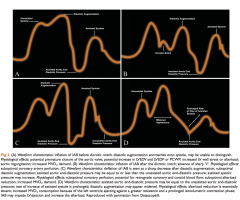
|
|
|
Repeat A 40 yo woman for laparotomy to remove phaeochromocytoma under combined epidural and general anaesthesia. Pre-operatively treated with phenoxybenzamine and metoprolol. Intra-operatively, blood pressure is 250/130 despite high dose phentolamine and SNP. HR is 70/min and SaO2 are 98%. The next most appropriate treatment is: A. Epidural Lignocaine B. IV Esmolol C. IV Hydralazine D. IV Magnesium E. IV Propofol |
D- IV Magnesium or Propofol |
|
|
Flow volume loop diagram A. Variable intra-thoracic obstruction B. Variable extra-thoracic obstruction C. Restrictive pattern D. Obstructive pattern E. Fixed obstruction |
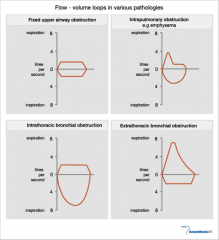
answer is B |
|
|
A 30 year old multi trauma patient one week post injury has severe ARDS. He is currently ventilated at 6ml/kg tidal volume, PEEP of 15cm H20 and pa02/Fi02 is less than 150. The next step to improve oxygenation is: A. increase PEEP to 20cmH20 B. increase tidal volume to 10mls/kg C. initiate nitrous oxide therapy D. commence high flow oscillatory ventilation E. ventilate in the prone position |
A or E depending on plateau pressures Probably should go with prone position - recent studies show early prone ventilation helps |
|
|
When topping up a labour ward epidural to an epidural for lower segment caesarean section, the optimum level of block when assessed for light touch is to: A. T2 B. T4 C. T6 D. T8 E. T11 |
B T4 |
|
|
You are involved in research and as part of data collection you collect ASA scores. This type of data is: A. Categorical B. Nominal C. Non-parametric D. Numerical E. Ordinal |
E. ordinal data there is an order among categories --> Ordinal data * Example: Pain score, ASA score There is no direct mathematical relationship with ordinal data * e.g. pain score of 6 is not really double that of a pain score of 3 |
|
|
During a pneumoperitoneum, at what level of intra-abdominal pressure does cardiac output fall? A. 10 mmHg B. 20 mmHg C. 30 mmHg D. 40 mmHg E. 50 mmHg |
A CEACCP article |
|
|
Best option to reduce risk of ventilator induced pneumonia? A. Nurse in supine position B. Early spontaneous ventilation through ETT C. Oral hygiene D. Use antacids E. Regularly change breathing circle |
C |
|
|
Which drug should be avoided both intra- and post operatively in a woman having surgery who is breast feeding a 6 week old baby? A. codeine B. morphine C. paracetamol D. parecoxib E. tramadol |
A |
|
|
A patient is in Class 4 haemorrhagic shock, secondary to a gunshot wound to the abdomen. He is clinically coagulopathic 30 minutes later. He has received intravenous Hartmann's 1L. The coagulopathy is likely related to: A. acidosis B. dilution of clotting factors C. hypothermia D. systemic release of tissue factor E. tissue hypoperfusion |
E |
|
|
Repeat The normal physiological response following ECT is A. transient tachycardia followed by bradycardia and hypotension B. transient bradycardia followed by tachycardia and hypertension C. unpredictable D. transient tachycardia followed by bradycardia and hypertension E. tachycardia and hypotension |
B. Oxford Handbook During the seizure there is parasympathtic hyperactivity (bradycardia and hypotension) lasting about 15s, then followed by a longer period of sympathetic stimulation (tachycardia and hypertension) 5mins |
|
|
In preadmission clinic with patient with a tracheostomy. To enable patient to talk you would- A. Deflate tracheostomy cuff, insert one-way valve, insert fenestrated piece B. Deflate tracheostomy cuff, remove one-way valve, insert fenestrated piece C. Inflate tracheostomy cuff, remove one-way valve, insert fenestrated piece D. Inflate tracheostomy cuff, insert one-way valve, insert fenestrated piece E. ? |
A- needs one way valve to allow exhalation through cords rather than trachae. Fenestration helps to allow air to pass out of trachae tube. deflate cuff otherwise will suffocate |
|
|
What is NOT a contraindication to MRI? A. Pulmonary artery catheter B. Arterial line C. Scissors D. Coiled ECG cable E. Laryngoscope |
B |
|
|
What is the mechanism of central sensitisation? A. Increased intracellular magnesium B. Antagonism of the NMDA receptor C. Glycine is the major neurotransmitter involved D. Recurrent a-delta fibre activation E. Alteration in gene expression |
E |
|
|
Which volatile contributes most to greenhouse gases / environmental pollutant ? A Desflurane B N2O C Sevoflurane D Isoflurane E Halothane |
A |
|
|
The clinical sign that a lay person should use to decide whether to start CPR is: A. Absent central pulse B. Absent peripheral pulse C. Loss of consciousness D. Obvious airway obstruction E. Absence of breathing |
E. Absence of breathing Loss of consciousness if still breathing = no cpr |
|
|
A patient's competence to give informed consent is determined by all the following except: A. Ability to communicate a choice B. Ability to apply reasoning C. Ability to understand consequences D. The provision of significant information E. ? |
D |
|
|
?? First line treatment for acute attack of hereditary angioedema A FFP B Adrenaline C Steroids D C1 inhibitor concentrate E anti-histamine |
D C1 inhibitor concentrate if not available: A. FFP |
|
|
Adult male who is intubated and ventilated, with CVL in situ. Just before surgeon starts the Line Isolation Monitor alarms about a leak at 5mA. What do you do? A. stop procedure and move to a safe location B. sequentially remove non essential monitors from the circuit until fault is identified C. unplug the CVL to electrically isolate it until fault is identified D. ensure the patient is earthed E. Check the diathermy pad |
B |
|
|
Patient with Haemophilia A with known high titres of inhibitors to factor 8. What would you give to prevent bleeding in the patient for OT a. FVIIa b. High dose FVIII concentrate c. FFP d. Cryo e. Platelets |
A |
|
|
55 year old subarachnoid haemorrhage secondary to aneurysm. Patient is confused with a oculomotor (3rd cranial nerve) palsy, complains of a severe headache. This patient is in Hunt and Hess class: A 0 B 1 C 2 D 3 E 4 |
D. Hunt and Hess: 1. Asymptomatic, mild headache, slight nuchal rigidity 2. Moderate to severe headache, nuchal rigidity, no neurologic deficit other than cranial nerve palsy 3. Drowsiness / confusion, mild focal neurologic deficit 4. Stupor, moderate-severe hemiparesis 5. Coma, decerebrate posturing |
|
|
In a 140kg obese patient, compared to a 70 kg person A. cardiac output >20% lower B. cardiac output 10% lower C. cardiac output no different D. cardiac output 10% higher E. cardiac output >20% higher |
E. Alexander et al. demonstratedthat cardiac output increased in proportion to the excessin body weight in obese subjects |

